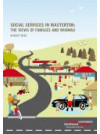This report responds to the Minister of Social Development’s request for a snapshot of all the social service providers in the Masterton area, how families know about them and which services they do, and do not, rely on when they need help.
The report includes the views of families and, to some extent, the views of providers. It is not an evaluation of the effectiveness of the programmes, except in the sense that it illustrates what families like and do not like about social services.
Although our snapshot of social services is broad, including medical and educational services and policing, our main emphasis throughout most of the report is on parenting and family support services.
Methodology
We used a mixed method research design – combining quantitative and qualitative approaches to collecting, analysing, interpreting, and reporting data, complemented by desk-based data analysis. This design incorporated the strengths of qualitative and quantitative approaches and provided a comprehensive view of families’ experiences and options. The approaches used to gather data are briefly outlined below. All work was undertaken during April to June 2010.
For the purposes of this report, we defined social services broadly as any service offered by government or non-government agencies; funded by government, donations, or grants of some sort, or provided unfunded by volunteers; that are designed to help individuals or families by providing assistance of some sort. This definition would capture policing, health services, education, social work, parenting training and support, justice services, some of the services provided by local authorities, much of the pastoral activity of churches, and much more. Any definition of social services is inexact, and judgements have to be made about what is to be included or excluded. For example, we have not included spiritual guidance as a social service, despite it fitting our definition.

